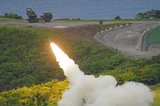Why the US cannot overcome Russian and Chinese hypersonic weapons
The Glide Phase Interceptor is intended to provide an advanced hypersonic missile defence capability. (Photo: Raytheon Missiles and Defense)
The risks posed by hypersonic weapons and Russian and Chinese advances in this realm have been a concern for the US and are pushing the Pentagon towards developing and improving its missile defence capabilities.
As hypersonic weapons do not follow a ballistic trajectory and can fly at low altitudes in addition to manoeuvring en route to their target, they challenge existing US defence systems.
A report issued by the Congressional Research Service (CRS) in February noted that both current terrestrial- and space-based sensor architectures are insufficient to identify and track this type of threat.
It stated that ‘terrestrial-based radar
Already have an account? Log in
Want to keep reading this article?
More from Defence Notes
-
![Taiwan approved for purchase of $11 billion in weapons from US]()
Taiwan approved for purchase of $11 billion in weapons from US
The US State Department’s approval of a multi-billion-dollar sale of weapons to Taiwan includes tactical mission networks equipment, uncrewed aerial systems, artillery rocket systems and self-propelled howitzers as well as anti-tank guided missiles.
-
![US National Security Strategy prioritises advanced military capabilities and national industry]()
US National Security Strategy prioritises advanced military capabilities and national industry
The 2025 NSS has emphasised investment in the US nuclear and air defence inventory and national industry, but it leaves multiple unanswered questions on how the White House will implement this approach.
-
![Canada set to look away from its neighbour and across the Atlantic for partners]()
Canada set to look away from its neighbour and across the Atlantic for partners
While non-EU UK struggles to join the Security Action for Europe initiative, which provides loans for defence programmes, Canada has become the first country outside Europe to get access – and did so for a nominal fee.
-
![NATO experiments with solutions to integrate networks, AI and uncrewed systems]()
NATO experiments with solutions to integrate networks, AI and uncrewed systems
During the latest edition of the NATO DiBaX, the alliance tested multiple capabilities to inform requirements for future efforts.
























